After its lead designer Adriaan Geuze conducted a systems analysis and mapped the opportunities for leveraging water safety on De Staart, the IABR–Atelier Dordrecht commissioned five research by design studies by five excellent design offices. The integral, sustainable, and socially inclusive urban development of the area was always the main objective and water safety the lever. And all five design offices were asked to incorporate all of the United Nations’ Sustainable Development Goals in the design process from the beginning, true to the IABR's core mission.
The infrastructure experts of VenhoevenCS propose an easily identifiable and climate-adaptive escape route that functions in everyday use as a new connection between the inner city, De Staart, and the Biesbosch. The urban designers and landscape architects of West 8 argue for new green structures and a Dordttrack to connect existing developments on De Staart and the Wantij-Merwede and to stimulate biodiversity. Studio Donna van Milligen Bielke, which researches urbanity and the use of the city, suggests a different approach to outdoor space that keeps the existing character of Dordrecht intact. A new type of building by EGM architects, expert in large-scale sustainable construction, seeks the optimally flexible mix of different forms of collective living and working. And PosadMaxwan, an urban design office with a future agenda, responds to the threat of flooding by conceiving an innovative form of living on water.
Each study is presented in THE HIGH GROUND by means of a video animation and a (series of) scale model(s), in which the relationship between the desired everyday use and the necessary use in times of flooding is made clear: What needs be done and what can be won.
START WITH THE OUTDOOR SPACE
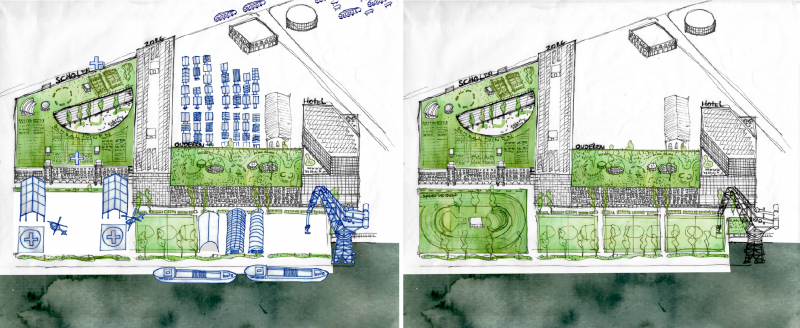
Artist's Impression THE HIGH GROUND
image: Studio Donna van Millegen Bielke (IABR–Atelier Dordrecht)
The IABR–Atelier Dordrecht has chosen to wield water safety as a lever and to take the Sustainable Development Goals (SDGs) as a starting point in the design process. The research by design done by Studio Donna van Milligen Bielke (DVMB) with Ard de Vries Architects investigated which structure of urbanization this can lead to on De Staart. The results demonstrate that in this scenario the development of the outdoor space should be leading. Especially since that outdoor space will have a dual function. On a daily basis it will be used as public space, with all the specific qualities required for that purpose. But in the event of flooding that same space has to transform quickly and efficiently into an effective infrastructure for evacuation.
Designing a multifunctional city with high density, water safety and the SDGs at the heart of the program of requirements therefore starts with designing the outdoor space.
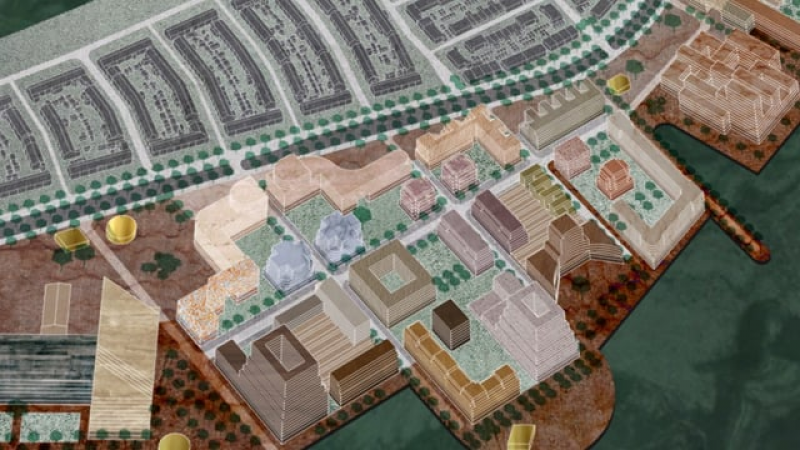
© IABR, 2021
LIVE ON THE WATER
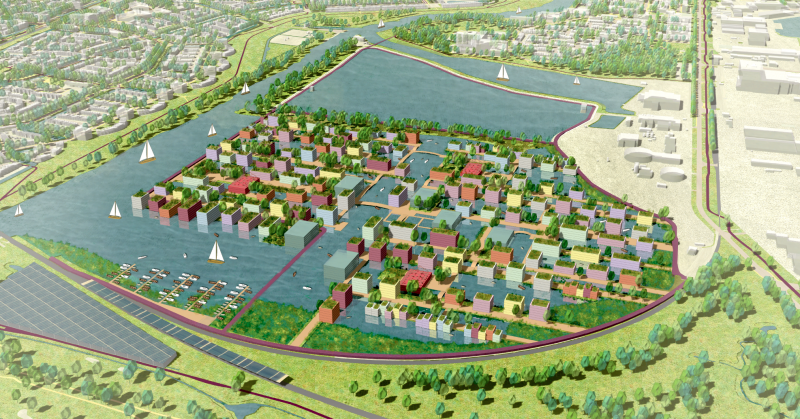
Live on the Water - De Staart, Dordrecht
image: Posad.Maxwan, IABR–Atelier Dordrecht
Because of climate change and urbanization, we are facing new spatial challenges in urban environments: there’s a shortage of housing, our lifestyles contribute to excessive CO2 emissions, and the risk of flooding is on the rise in waterfront cities.
With the design for a floating city in the former Grote Rug reservoir, design office PosadMaxwan investigated how development on the water can contribute to sustainable urbanization and at the same time create a unique living environment. Whereas current water districts are often inaccessible, low-density residential enclaves, Waterstad De Grote Rug distinguishes itself by a mix of functions, attractive public spaces, and buildings of up to six stories high constructed sustainably of wood and floating on dismountable polystyrene modules. Energy is generated by water and wind, and rainwater is collected for use in the homes. Transportation is by foot over a dense network of piers and by means of a public, electric shared-boat system. Space for cars is unneeded, so that high density can be combined with green, biodiverse outdoor space. Centrally located in each neighborhood is a hub where amenities, vegetable gardens, and workplaces are shared, so that a sustainable, inclusive community can emerge on the water.

© IABR, 2021
INCREASE POTENTIAL

THE HIGH GROUND - increase potential
model by West 8 - image: Aad Hoogendoorn
From the perspective of water safety, fast connections are not only needed in the urban area of Dordrecht itself.
Design office West 8 therefore proposes a new recreational (cycling) route, the Dordttrack, that will run from the center of Dordrecht across De Staart to Gorinchem, connecting various locations in the region. Thanks to this increase in scale, neighborhood centers acquire an urban importance as well. For example, a community center could be transformed into a pavilion with a beach that can be visited from anywhere in the region. Biodiversity can also receive more attention. Sloping banks make the water more accessible and expand the recreational possibilities: the Wantij becomes the ultimate playground.
Small-scale recreational areas can be given a second function thanks to the water-safety-as-leverage approach. This not only increases their appeal and potential for everyday use, but during an evacuation they can be used as crucial central distribution hubs that many people will already know how to find relatively easily.
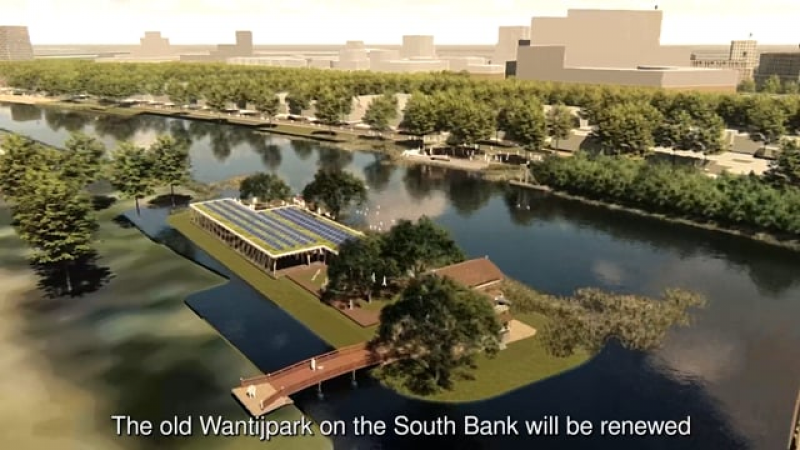
© IABR, 2021
BUILD FOR FLEXIBILITY
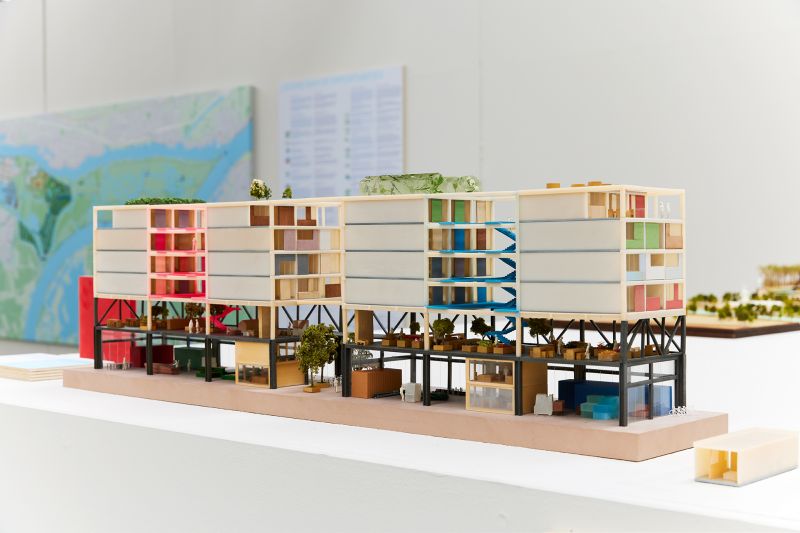
THE HIGH GROUND - build for flexibility
model: EGM/Made by Mistake - image: Aad Hoogendoorn
The IABR–Atelier made an analysis at the level of the city and of the district, but also conducted research at the building level. To turn De Staart into a high-density city with numerous additional functions, that is also able to serve as a temporary refuge in the event of an emergency, requires a flexible building type.
EGM architects designed a multifunctional and energy-neutral building that can be produced economically and quickly. This sustainable building is attractive to different types of residents. The multifunctional base is ideal for start-up companies, as rents can remain low. The building is composed of different modules, a standard unit can be divided, combined, and expanded in different ways, to facilitate different living needs. Above the base, space has been reserved that can be filled with public functions, also for people from the neighborhood who don’t live or work in the building, while a large number of evacuees can be accommodated here in times of flooding. Inside are a market square and meeting places, among other things, and the green roof offers space for urban farming. The result is a rich and diverse live-work complex that facilitates cooperation and community, also in times of catastrophe.

© IABR, 2021
CHOOSE TO CONNECT

DOWN TO EARTH: THE HIGH GROUND
model by Made by Mistake - image: Aad Hoogendoorn

THE HIGH GROUND - choose to connect
model: VenhoevenCS
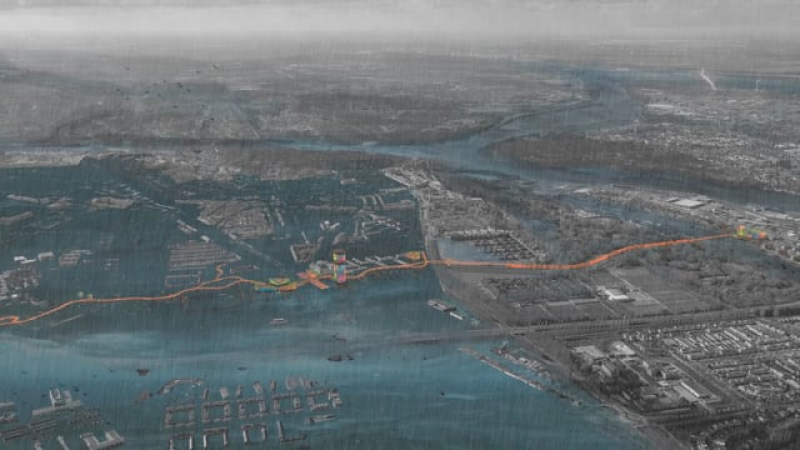
© IABR, 2021